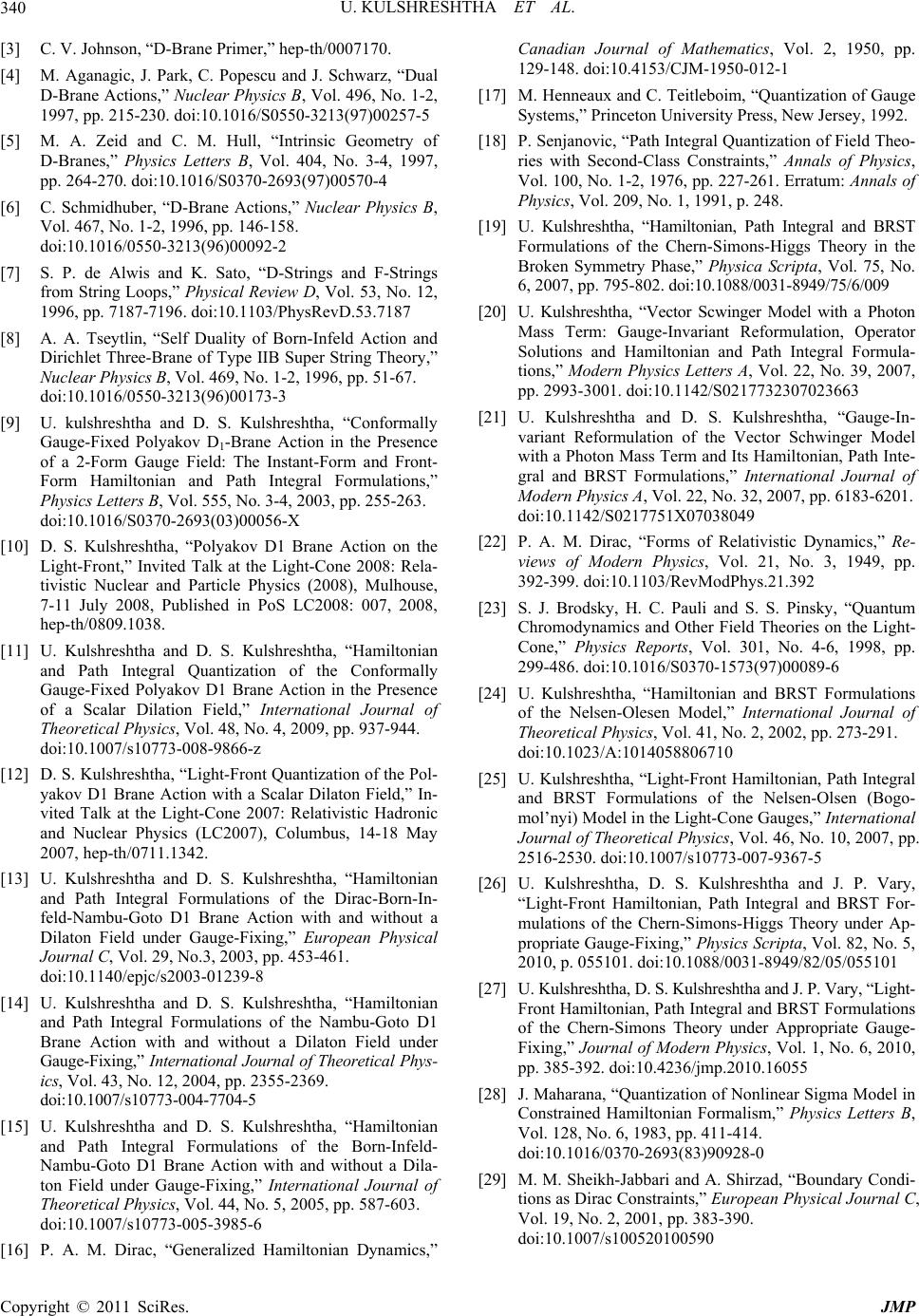
U. KULSHRESHTHA ET AL.
Copyright © 2011 SciRes. JMP
340
u and J. Schwarz, “
. 1-2,
ngs and F-S
D, Vol. 53, No. 12,
y
tion in the Presence
-Cone 2008: Rela-
Quantization of the Conform
-
calar Dilaton Field,” In-
lations of the Dirac-Born-In-
amiltonian
f the Nambu-Goto D1
“Hamilt
s of the Born-Infeld-
ics, Vol. 2, 1950, pp.
w Jersey, 1992.
gs Theory in the
tor
Model
1, No. 3, 1949, pp.
the Light-
ournal of
e Nelsen-Olsen (Bogo-
BRST For-
s
sics Letters B,
d, “Boundary Condi-
Physical Journal C,
[3] C. V. Johnson, “D-Brane Primer,” hep-th/0007170.
[4] M. Aganagic, J. Park, C. PopescDual
129-148.
D-Brane Actions,” Nuclear Physics B, Vol. 496, No
1997, pp. 215-230. doi:10.1016/S0550-3213(97)00257-5
[5] M. A. Zeid and C. M. Hull, “Intrinsic Geometry of
D-Branes,” Physics Letters B, Vol. 404, No. 3-4, 1997,
[18]
pp. 264-270. doi:10.1016/S0370-2693(97)00570-4
[6] C. Schmidhuber, “D-Brane Actions,” Nuclear Physics B,
Vol. 467, No. 1-2, 1996, pp. 146-158.
doi:10.1016/0550-3213(96)00092-2
[7] S. P. de Alwis and K. Sato, “D-Stri
from String Loops,” Physical Review
trings Broken Symmetry Phase,” Physica Scripta, Vol. 75, No.
6, 2007, pp. 795-802.
1996, pp. 7187-7196. doi:10.1103/PhysRevD.53.7187
[8] A. A. Tseytlin, “Self Duality of Born-Infeld Action and
Dirichlet Three-Brane of Type IIB Super String Theory,”
So
Nuclear Physics B, Vol. 469, No. 1-2, 1996, pp. 51-67.
doi:10.1016/0550-3213(96)00173-3
[9] U. kulshreshtha and D. S. Kulshreshtha, “Conformall
Gauge-Fixed Polyakov D1-Brane Ac
of a 2-Form Gauge Field: The Instant-Form and Front-
Form Hamiltonian and Path Integral Formulations,”
Physics Letters B, Vol. 555, No. 3-4, 2003, pp. 255-263.
doi:10.1016/S0370-2693(03)00056-X
[10] D. S. Kulshreshtha, “Polyakov D1 Brane Action on the
Light-Front,” Invited Talk at the Light
with
tivistic Nuclear and Particle Physics (2008), Mulhouse,
7-11 July 2008, Published in PoS LC2008: 007, 2008,
hep-th/0809.1038.
[11] U. Kulshreshtha and D. S. Kulshreshtha, “Hamiltonian
and Path Integralally
Cone,” Physics Reports, Vol. 301, No. 4-6, 1998, pp.
299-486.
Gauge-Fixed Polyakov D1 Brane Action in the Presence
of a Scalar Dilation Field,” International Journal of
Theoretical Physics, Vol. 48, No. 4, 2009, pp. 937-944.
doi:10.1007/s10773-008-9866-z
[12] D. S. Kulshreshtha, “Light-Front Quantization of the Pol
yakov D1 Brane Action with a S
Theo
vited Talk at the Light-Cone 2007: Relativistic Hadronic
and Nuclear Physics (LC2007), Columbus, 14-18 May
2007, hep-th/0711.1342.
[13] U. Kulshreshtha and D. S. Kulshreshtha, “Hamiltonian
and Path Integral Formu
feld-Nambu-Goto D1 Brane Action with and without a
Dilaton Field under Gauge-Fixing,” European Physical
Journal C, Vol. 29, No.3, 2003, pp. 453-461.
doi:10.1140/epjc/s2003-01239-8
[14] U. Kulshreshtha and D. S. Kulshreshtha, “H
and Path Integral Formulations o
mula
Brane Action with and without a Dilaton Field under
Gauge-Fixing,” International Journal of Theoretical Phys-
ics, Vol. 43, No. 12, 2004, pp. 2355-2369.
doi:10.1007/s10773-004-7704-5
[15] U. Kulshreshtha and D. S. Kulshreshtha,
and Path Integral Formulation
onian
Vol. 128, No. 6, 1983, pp. 411-414.
Nambu-Goto D1 Brane Action with and without a Dila-
ton Field under Gauge-Fixing,” International Journal of
Theoretical Physics, Vol. 44, No. 5, 2005, pp. 587-603.
doi:10.1007/s10773-005-3985-6
[16] P. A. M. Dirac, “Generalized Hamiltonian Dynamics,”
Canadian Journal of Mathemat
Vol.
doi:10.4153/CJM-1950-012-1
[17] M. Henneaux and C. Teitleboim, “Quantization of Gauge
Systems,” Princeton University Press, Ne
P. Senjanovic, “Path Integral Quantization of Field Theo-
ries with Second-Class Constraints,” Annals of Physics,
Vol. 100, No. 1-2, 1976, pp. 227-261. Erratum: Annals of
Physics, Vol. 209, No. 1, 1991, p. 248.
[19] U. Kulshreshtha, “Hamiltonian, Path Integral and BRST
Formulations of the Chern-Simons-Hig
doi:10.1088/0031-8949/75/6/009
[20] U. Kulshreshtha, “Vector Scwinger Model with a Photon
Mass Term: Gauge-Invariant Reformulation, Opera
lutions and Hamiltonian and Path Integral Formula-
tions,” Modern Physics Letters A, Vol. 22, No. 39, 2007,
pp. 2993-3001. doi:10.1142/S0217732307023663
[21] U. Kulshreshtha and D. S. Kulshreshtha, “Gauge-In-
variant Reformulation of the Vector Schwinger
a Photon Mass Term and Its Hamiltonian, Path Inte-
gral and BRST Formulations,” International Journal of
Modern Physics A, Vol. 22, No. 32, 2007, pp. 6183-6201.
doi:10.1142/S0217751X07038049
[22] P. A. M. Dirac, “Forms of Relativistic Dynamics,” Re-
views of Modern Physics, Vol. 2
392-399. doi:10.1103/RevModPhys.21.392
[23] S. J. Brodsky, H. C. Pauli and S. S. Pinsky, “Quantum
Chromodynamics and Other Field Theories on
doi:10.1016/S0370-1573(97)00089-6
[24] U. Kulshreshtha, “Hamiltonian and BRST Formulations
of the Nelsen-Olesen Model,” International J
retical Physics, Vol. 41, No. 2, 2002, pp. 273-291.
doi:10.1023/A:1014058806710
[25] U. Kulshreshtha, “Light-Front Hamiltonian, Path Integral
and BRST Formulations of th
mol’nyi) Model in the Light-Cone Gauges,” International
Journal of Theoretical Physics, Vol. 46, No. 10, 2007, pp.
2516-2530. doi:10.1007/s10773-007-9367-5
[26] U. Kulshreshtha, D. S. Kulshreshtha and J. P. Vary,
“Light-Front Hamiltonian, Path Integral and
tions of the Chern-Simons-Higgs Theory under Ap-
propriate Gauge-Fixing,” Physics Scripta, Vol. 82, No. 5,
2010, p. 055101. doi:10.1088/0031-8949/82/05/055101
[27] U. Kulshreshtha, D. S. Kulshreshtha and J. P. Vary, “Light-
Front Hamiltonian, Path Integral and BRST Formulation
of the Chern-Simons Theory under Appropriate Gauge-
Fixing,” Journal of Modern Physics, Vol. 1, No. 6, 2010,
pp. 385-392. doi:10.4236/jmp.2010.16055
[28] J. Maharana, “Quantization of Nonlinear Sigma Model in
Constrained Hamiltonian Formalism,” Phy
doi:10.1016/0370-2693(83)90928-0
[29] M. M. Sheikh-Jabbari and A. Shirza
tions as Dirac Constraints,” European
19, No. 2, 2001, pp. 383-390.
doi:10.1007/s100520100590